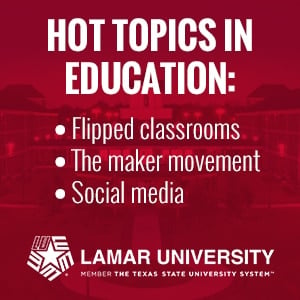
Current education trends include everything from understanding the controversial Common Core State Standards to concerns about student privacy and school lunch programs. And the age-old conversations on high-stakes testing and reading instruction philosophies continue. Many people are not aware of the complicated issues facing the educational system. But three topics have everyone talking, both inside and outside schools: flipped classrooms, the maker movement, and social media in the classroom.
Flipped Classrooms
In 2008, two Colorado high school science teachers, Jonathan Bergmann and Aaron Sams, discussed how difficult it was to find time to help students who missed in-school class work. So they tried something new. Instead of pulling those students aside and working with them individually, they started recording and posting their lessons and related materials online so that students could catch up outside class.
Both teachers were surprised to learn that other students, even those not absent from class, started using the online information to review material and prepare for tests. In fact, this new idea proved so successful that they pursued the idea of completely changing their instructional approach. They flipped the classroom.
In a flipped classroom, students watch teacher-created videos or interactive lessons at home in advance of the lesson. In the original Bergmann-and-Sams model, students are required to come to class prepared with detailed notes of the video and at least one question. Then, students use class time to work collaboratively on problems and activities that support and enhance understanding of the information they have already heard. The teacher is free to work with individuals or groups that have specific questions or seem to be stuck on a problem.
This innovative education trend has proven to be a student motivator. In addition, flipped classrooms promote student collaboration and a willingness to work in groups — something many future employers believe holds the key to business success.
The Maker Movement
Students at The Computer School in New York City are spending lunchtime in the school’s Maker Space. There, they design and build video games, robots or wearable computers. Other schools offer classes in which students build rockets, use 3D printers or make movies. Even schools with fewer financial or technology resources create Maker Spaces by using found objects, art materials and even duct tape to equip the space.
In creating, these students are experiencing the best of the Maker Movement. Dr. Gary Stager, co-author of Invent to Learn, explains the benefits: “The shift to ‘making’ represents the perfect storm of new technological materials, expanded opportunities, learning through firsthand experience, and the basic human impulse to create. It offers the potential to make classrooms more child-centered: relevant and more sensitive to each child’s remarkable capacity for intensity.”
Social Media in the Classroom
Opening classrooms up to the enormous world of social media is tricky. But this education trend is proving to be a valuable instructional tool. For example, Edmodo is a free, school-friendly online alternative to Facebook. Teachers and students can post comments and ask and reply to questions. Students can also turn in assignments and receive personal feedback in a mode that is second nature to them.
Classroom teachers also use social media sites like Google Docs, YouTube and Pinterest to enhance instruction. Although the risk of inappropriate use and content is very real, teachers, administrators and students who develop clear, non-negotiable standards and a high level of trust in each other can benefit from these interactive sites. Many students even bring hardware to the classrooms in their pockets — smartphones are often far superior to the outdated desktop computers in many schools.
To keep up with education trends, many experienced educators are returning to college for post-graduate work like a master’s degree in teacher leadership. These degrees now include courses in research and current issues in education. As degree candidates discuss new trends, techniques and methodologies in teaching, they decide how best to engage students and achieve meaningful academic progress. Whether graduate students pursue instructional leadership or school team leadership positions, it is critical that they keep up with education trends to make a greater impact on the success of their students.
Learn more about Lamar University Master of Education in Teacher Leadership online.
Sources:
The Journal: What’s Hot, What’s Not in 2016
Education Degree: Education Reform Trends In 2016
ASCD: Why You Should Flip Your Classroom
Education Next: The Flipped Classroom
Scholastic: What’s the Maker Movement and Why Should I Care?
Education World: Study Suggests Benefits of Social Media in the Classroom
PBS News Hour: Should Teachers Be Using Social Media in the Classroom?